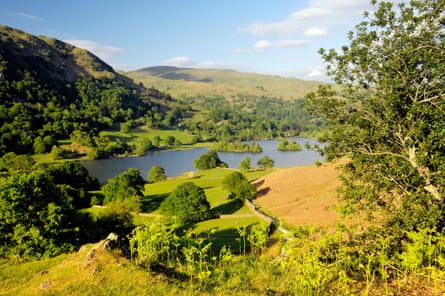
I love going to Cumbria. It’s my spiritual home and a great place to go to feel connected with nature. The first town I stayed in, maybe 20 years ago, was Ambleside, at the top of Lake Windermere. It’s a lovely resting place and you can set out in almost any direction and have wonderful walks with wonderful scenery. Sometimes we’ll walk for seven or eight hours to Grasmere or up to Lake Rydal, and have a picnic overlooking the valleys and lakes.
Go in the springtime and you’ll see the snow-capped hills with a blue sky behind them and fields of daffodils. Go in autumn and you’ll see golden leaves, which remind me of the Windrush generation when they came to Britain, saying the streets were paved with gold – when the land is golden like this, you actually understand the meaning of it.
The walk, from Ambleside to Stock Ghyll Force, is quite short, but it’s a walk of great excitement, especially for children, because your destination is a 70-foot waterfall crashing down through the trees. It’s rare to have a waterfall at the edge of a town; normally you have to go quite far into the countryside to see one. It’s about 30 minutes to the top, if you don’t stop, and it’s quite an uphill trek, but not over-steep, so it’s good for older people, too. If you have children, it’s a walk that you can do with them for many years to come – and they will take their own children there in turn.
Starting from Lake Road in the centre of Ambleside, turn left onto Stockghyll Lane, walk past the public toilets and follow signs to the waterfall. Go up the hill and around to the right and, in about 500 metres, you’ll see a left turn with a signpost to Stock Ghyll Force. Ta-dah! Open the gate and go through, but be careful: it’s quite muddy here because of all the water. Follow the path through the woods, keeping the river on your left and looking out for the red marker posts.
You get a sense of history as you do this walk – visitors have been doing it since the Victorian days, when in fact you had to pay. Stock Ghyll is a tributary of the River Rothay and, for centuries, the water crashing down these falls was used to power water mills, to process wool, make bobbins and grind corn. The river flows into the town through the famous Bridge House, which dates back to the 17th century.
As you begin to climb, you see the bottom of the waterfall. You can tell it’s powerful because it makes a lot of noise. There are several stages to the falls and, as you climb, there are lots of places where you can stop and admire the view. It’s a friendly walk, too, and you’ll probably end up chatting to people on the way.
If there in the springtime, there’s a smell of onions – that’s coming from the daffodils, which are related to the onion family. You see moss and ivy and trees that have been there for hundreds of years. It feels a bit like The Lord of the Rings, and you wonder: if this tree could talk, what would it be telling you?
As you go further up, you start to see the waterfall in its full glory, cascading down towards you. It’s got this loud, beating call that really invites excitement. There’s always the laughter of children as well, caught up in the thrill of seeing and hearing the rushing water.
Nearing the top, you see the whole thing gushing down, with all the greenery around it. There’s a little footbridge to your left where you can stand looking down on the waterfall. Over the years, we’ve amassed loads and loads of photos of ourselves posing on this bridge. I always take my shoes and socks off and put my feet in the ice-cold water. I love doing that.
When you get to the very top, there’s a public area where you can stop and have a picnic. Lots of people leave their initials on the tree trunks or the table saying, “I was here”. I remember once lying with my husband in one of the fields above the waterfall, feeling glorious, and suddenly I was very aware that we weren’t alone. We opened our eyes and we were surrounded by sheep. There was one particular animal who obviously was the bad guy of the flock, because she looked so menacing. She was looking at us as if to say, “what the hell are you doing in my patch?” My husband said: “Just very gently roll down the hill and we’ll be fine.”
Walking back down to Ambleside is another challenge, because the path is quite steep and the steps are uneven. I used to do the London marathon, so my knees are a bit dodgy, so I’d usually pick up a stick and walk down with it.
I always cry when I have to leave Cumbria, but my husband always says: “There’s always next time.” So we’re looking forward to that – we try to go twice a year, in springtime and again in the autumn, because you get a completely different experience. And I would say to everybody, just go on a walk. It’s great for if you’re feeling down. If you suffer from depression or anxiety, go out and do one of those walks. It uplifts your soul and you feel spiritually connected. And if you feel spiritually connected to nature, then everything falls into place: you realise the importance of you on earth, and the importance of everything around you, and how we’re all connected.



